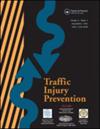虚拟约束装置扩展儿童约束装置服务范围的可接受性:一项试点随机对照试验。
IF 1.6
3区 工程技术
Q3 PUBLIC, ENVIRONMENTAL & OCCUPATIONAL HEALTH
引用次数: 0
摘要
目的:儿童约束装置的不正确使用是一个长期存在的问题,限制了儿童约束装置在撞车事故中提供的保护。儿童约束装置服务是减少不正确使用的一项措施,但对服务不足人群的覆盖面和可得性有限。虚拟儿童约束装置服务有可能增加覆盖范围和可用性,但与任何数字干预一样,需要用户接受才能有效。这种干预措施的可接受性以前还没有研究过。方法:采用三臂随机对照试验,对以下三种方法的可接受性进行评估:(1)带有儿童约束装置建议的视频(Control),(2)传统的现场儿童约束装置服务(in-person),以及(3)虚拟儿童约束装置服务(virtual)。此外,还评估了减少不正确使用的有效性。结果:与对照组相比,该组对亲自服务的总体接受程度显着提高,并且在儿童约束使用方面的错误显着减少。虚拟服务和对照组之间在总体可接受性或错误方面没有显著差异。然而,对可接受性构式的深入分析表明,面对面服务组和虚拟服务组的参与者对七个构式中的四个构式持有相似的观点,包括服务的有用性和服务对正确使用约束的关键信息的理解的影响。这些群体之间意见不同的领域包括感知负担、适当性和机会成本。定性反馈表明,这些对虚拟服务的负面看法可能会随着技术的改进而得到纠正。结论:总的来说,提供的儿童约束装置服务实际上显示了作为面对面服务的替代方案的希望,但可能需要注意如何通过这项技术提供服务,以及技术改进,以充分发挥其潜力。本文章由计算机程序翻译,如有差异,请以英文原文为准。
Acceptability of virtual restraint fitting to extend the reach of child restraint fitting services: A pilot randomized controlled trial
Objective
Incorrect use of child restraints is a long-standing issue, limiting the protection offered by child restraints in the event of a crash. Child restraint fitting services are a measure to reduce incorrect use but have limited reach and availability to underserved populations. Virtual child restraint fitting services have the potential to increase the reach and availability, but as with any digital intervention, need to be acceptable to users to be effective. The acceptability of such interventions has not been studied before.
Methods
Using a three-arm randomized controlled trial, this study evaluated the acceptability of: (1) a video with child restraint fitting advice (Control), (2) a traditional in-person child restraint fitting service (In-person), and (3) a virtual child restraint fitting service (Virtual). Additionally, the effectiveness in reducing incorrect use was evaluated.
Results
There was a significantly higher level of overall acceptability for the in-person service, and significantly fewer errors in child restraint use in this group compared to the control. There were no significant differences in overall acceptability or errors between the virtual service and the control. However in-depth analysis of the constructs of acceptability demonstrated participants in the in-person and virtual service groups held similar views on four of the seven constructs including the usefulness of the services and the impact of the service on comprehension of key information for correct restraint use. Areas where the views differed between these groups included perceived burden, appropriateness, and opportunity costs. Qualitative feedback suggested these negative perceptions on the virtual service may be remediated with some improvements to the technology.
Conclusions
Overall, child restraint fitting services provided virtually show promise as an alternative to in-person but attention to how services are provided via this technology, together with technology improvement, might be needed to fully realize its potential.
求助全文
通过发布文献求助,成功后即可免费获取论文全文。
去求助
来源期刊

Traffic Injury Prevention
PUBLIC, ENVIRONMENTAL & OCCUPATIONAL HEALTH-
CiteScore
3.60
自引率
10.00%
发文量
137
审稿时长
3 months
期刊介绍:
The purpose of Traffic Injury Prevention is to bridge the disciplines of medicine, engineering, public health and traffic safety in order to foster the science of traffic injury prevention. The archival journal focuses on research, interventions and evaluations within the areas of traffic safety, crash causation, injury prevention and treatment.
General topics within the journal''s scope are driver behavior, road infrastructure, emerging crash avoidance technologies, crash and injury epidemiology, alcohol and drugs, impact injury biomechanics, vehicle crashworthiness, occupant restraints, pedestrian safety, evaluation of interventions, economic consequences and emergency and clinical care with specific application to traffic injury prevention. The journal includes full length papers, review articles, case studies, brief technical notes and commentaries.
 求助内容:
求助内容: 应助结果提醒方式:
应助结果提醒方式:


